The Fire Still Burns
May 22, 2008 – Everyone has heard of Silent Hill, and Resident Evil is very nearly a household name at this point. If you dig a little deeper and look at the origins of the survival horror genre of video games, you will notice that both of these series have basically just built upon what the original Alone in the Dark had pioneered.
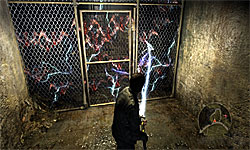
Before Silent Hill and Resident Evil were even glimmers in their respective developers’ eyes, Alone in the Dark was giving PC gamers 3D characters, backgrounds, and combat mixed with just the right amount of random puzzle solving. Having been noticeably absent from the spotlight for a few years now, it is easy to see how many gamers may not remember the forefather of modern survival horror games. I’m happy to say that Alone in the Dark (AITD) is back and will definitely leave an impression that will not soon be forgotten.
AITD will once again have you playing the role of Edward Carnby, who many fans will remember from the first title in the series. Carnby has somehow ended up in modern day Central Park without aging a day and with absolutely no recollection as to who he is. The game begins in first-person with Carnby lying on a bed, vision blurred beyond recognition, with several voices discussing story elements that will not make sense until later in the game. As you become more coherent, you can click the right stick to make Carnby blink, temporarily clearing your vision. While this is seemingly a minor thing, it draws you immediately into the experience and sets the tone for what Alone in the Dark is really trying to accomplish. That is, to tell an intriguing and cinematic story by totally immersing the player in the game world.
As much as Bioshock was universally deemed a thinking man’s shooter, AITD is a thinking man’s survival horror game. Many games in this genre have relied heavily on collecting and hoarding a wide variety of weapons and ammunition that were key to blasting your way to survival. AITD takes a different approach, making firearms and ammunition almost a complete afterthought. Instead, players will need to learn how best to mix and match items from their inventory to gain the upper hand or just use anything that isn’t bolted down as an instrument to deliver pain.
While checking desks and cabinets, you are bound to stumble upon a variety of everyday objects that you can collect. Once found, these items, like twenty dollar replica watches from a street vendor, will be stored under Carnby’s coat. You can access your inventory at any point and begin to mix items into whatever you may need at the time. If you have a bottle of fuel, a rag, and a lighter, you can rig a makeshift moltov cocktail or even just throw the bottle and shoot it with your gun to create a mobile fire bomb. Non-lethal tricks will also be possible such as strapping tape to a flare and throwing it onto an enemy to use it as a distraction. There are honestly too many options to list here, but rest assured, if you can think it you can most likely do it, and creativity is key.
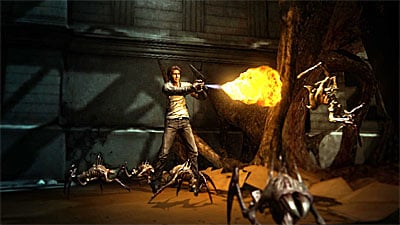
If you are running short on supplies or just want some up close and personal combat, there are a plethora of tools to get the job done. In the short time I played the game I found cleavers, swords, paintings, chairs, ashtrays, lamps, and fire extinguishers that could all be used to incapacitate foes. However instead of just pressing a button to attack, players are given a full range of movement with these objects. Once in hand, objects can be swung or held in place using the right analog stick. This worked fairly well during combat but really shined as a means for puzzle solving. Is a live electrical wire getting in your way? Simply pick up a stick and safely maneuver it away from your destination. Can’t see where you are going? Just grab a chair, hold it over some fire for a while, and you will have an instant makeshift torch.
The ever-present chair torches show off another of this game’s interesting new features. Real World Rules may sound like a marketing gimmick, but they honestly add much to AITD’s immersive experience. Every object in the game will catch fire realistically and burn away in real time. Chairs will catch fire easily, and as the flames spread, they will eventually be reduced to nothing but embers and ash. While in a building early in the game, flaming beams will fall onto hardwood flooring, basically setting a timer as you try to outrun the advancing inferno as it creeps slowly towards you. Spreading fires and chair torches will also provide realistic lighting as well as your only means of truly vanquishing your foes. As described by the developers, fire really is your greatest ally and enemy at the same time.

AITD also sets itself apart from its peers in the way that the story is delivered. The game follows a television series approach with its levels, spanning several chapters made up of smaller, somewhat contained segments. Every chapter in the game will end on a cliffhanger and begin with a brief “previously on AITD” recap to bring you up to speed. All the game’s chapters can be played through in order or skipped entirely. Essentially fast forwarding through chapters and segments will have you missing chunks of the game’s storyline, but may be an excellent alternative to putting the controller down for some. Instead of getting frustrated by failing to complete the same objective multiple times, just skip ahead to the next, and perhaps try it again later. Players will not have to complete every objective to see the climax of AITD but the ending will most likely be better, or at least more meaningful, if you do.
The game also looks pretty stellar, with its characters showing an excellent amount of detail. From intricate details like facial pores to visible injuries and scars, Carnby and company show no signs of being mistaken for plastic dolls. A wide variety of animations are also included to keep characters’ movements from feeling stale. The water, fire, and lighting effects aren’t too shabby to look at either. I could easily watch AITD’s objects being progressively consumed by fire for more than ten minutes at a time and still be entertained by the experience. You really need to see this game in motion to appreciate just how pleasing the visuals can be.
My only real concern with the game was how the camera would be handled since the right stick is preoccupied with maneuvering objects. Fortunately, although you can’t control the camera, it does a fantastic job of giving you an appropriate and visually appealing view at all times. While shimmying on a building’s ledge early in the game, the camera will be placed above you, looking down towards the street as a car explodes and launches towards you. In that same segment the camera will then pan below you to show random chunks of the building crashing down upon you, trying to end your adventure prematurely. Even while indoors the camera does a decent job of moving to a cinematic and functional vantage point that actually helps to drive the gameplay by drawing attention to specific points of interest.
Whether you are a newcomer to the series or have been there since the beginning, AITD shouldn’t disappoint. With its episodic and cinematic approach, AITD’s story will pull you in and keep you playing until the credits roll. Although it may have taken a lengthy vacation from popularity, AITD as a series is back and better than ever. Look for this game to put the franchise back on the map in a big way when it is released for everything but the PS3 in late June. Sony fans will have to wait until sometime during the fall to get lonely and dark, but the wait should still be well worth it.
Game Features:
Alone in the Dark brings horror to next-gen systems
March 1, 2007 – A series that began on PC in 1992, Alone in the Dark is looking to make its first next-gen appearance a realistic and terrifying one. Giving inspiration to such games as Resident Evil and Silent Hill, Alone in the Dark helped pioneer the survival-horror genre. Now publishers at Atari are focused on expanding the game’s image of survival-horror to more of a story-driven action game. Of course, AITD promises to remain as nerve-racking as ever, with evil lurking around every corner.

Though the original game took place in 1926, Edward Carnby is back to battle the paranormal in present-day Central Park in New York City. How Carnby hasn’t aged since 1926 is beyond me, but Atari says there is an explainable logic that may even tie in with the game’s plot.
The Central Park backdrop will be different from the narrow corridors and unlit rooms we’re used to seeing in these types of games, though the eerie atmosphere of the park at night promises to be as freaky as ever. As Carnby travels though a dim and uncomfortable Central Park, he will be able to interact with almost every object he can find in the fully interactive real-time environment. The ability to use your surroundings in different ways will allow a number of methods to pass certain tasks.
“Our new format for Alone in the Dark greatly enhances the pace and tension, keeping players permanently hooked into the engrossing story surrounding the mysteries of Central Park and beyond,” said Eden Games Director David. “You barely have time to breathe before the next cliffhanger hits you.”
Eden is working on a more realistic game with a whole new appearance and cinematic feel. 2005 blessed us with an easily forgotten film adaptation of Alone In The Dark, starring a poorly cast Christian Slater as Carnby. This may be part of the reason why Eden are concentrating highly on the game’s depth of field, motion blur, and dense lighting effects to make it feel more like a film or television series.
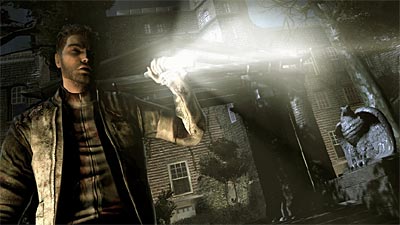
And the next-gen Alone in the Dark is set up very much like a television series, with an entirely new game structure. The story will be divided into 30-40 minute episodes the player must pass one at a time. The end of each episode will feature a suspenseful cliffhanger much like a television series that will leave the player wanting to move on and find out what happens next. Each time the player enters a new game or loads a previous game, the episode begins with a summary of what happened on the previous episode.
The developers at Eden have gone through some lengths to innovate new ways of playing the game. Like most games of this nature, the player builds up his inventory of weapons that can be switched back in forth in order. Eden are trying to avoid a HUD type of game, with no menus or health meters. In Alone In the Dark, all weapons and gadgets will be inside Carnby’s jacket and the player will be able to pick items from his pockets with a button-click. In high-tense situations, players will be able to quickly grab an object, put it away, and grab a different object. This better simulates real-life, as it limits the amount of weapons you can possess to what the average person could actually carry.
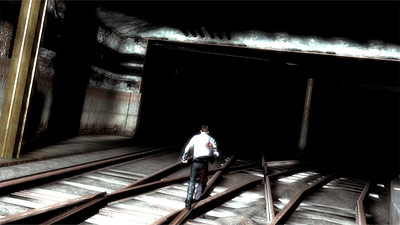
Also new to Alone in the Dark, the player will be able to enter a vehicle and then switch from driver’s seat to passenger seat and backseat with a flick of the analog. In moments of self-defense, the player will also be able to shoot through the car windows when being attacked by supernatural beings. Switching from seat to seat within the car will be vital to getting different vantage points when shooting at attackers.
The new Alone in the Dark will also require the player to earn skill in hotwiring. Contrary to what popular video games have taught us, most parked cars do not already come with keys in the ignition. The player will have to use stealth when breaking into cars and become accustomed to ripping apart the steering column and lining up the proper wires to start the engine. Line up the wrong wires, however, and you will set off the car alarm, drawing attention from enemies. Upon starting a car, the player will be involved in mission that require skilled driving and weaving through fires and demolished cars.
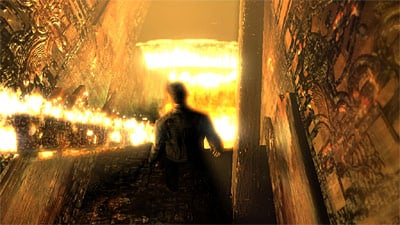
After giving life to a genre, Atari is continuing to innovate modern gaming with its horror-survival series. While they have only given us a glimpse of the long-awaited sequel thus far, Alone in the Dark promises to make a triumphant return with another heart-thumping survival experience.
Features:
May 3, 2006
Can Eden raise the dead and restore life to the original survival horror series? by Vaughn Smith
Before gamers were formally introduced to Chris Redfield, Leon S. Kennedy, Jill Valentine and Harry Mason (3 points if you know what game Harry’s from) there was Edward Carnby. While many credit Capcom’s Resident Evil franchise as being the first survival horror game, it was Infogrames’ Alone in the Dark released a full three years before the PlayStation would go on sale and four years before RE would hit the shelves in February 1996.
Edward Carnby, AITD’s bowtie-wearing, zombie-punching protagonist has seen his fair share of change since his first appearance 14 years ago. He’s went from an Ichobod Crane look-a-like to brooding long haired hero to Christian Slater (in the craptacular film) to his new appearance in AITD: NDE which looks to be cross between Ben Affleck and Ryan Seacrest. In that case maybe he’ll scare the monsters out of the game with his bad acting or simply get America to vote them out.

Pretty boy or not, it does look like Carby has his work cut out for him in his latest adventure. While the original game(s) took place in the 20th century – the 1920’s to be exact – NDEs timeline places our hero in 2006 smack dab in the middle of New York’s Central Park. I don’t know about you, but Central Park at night is scary enough. Part of the mystery Carnby will have to solve along the way is why he’s in 2006….and why are hotdogs, like $4? The setting will allow gamers a wide open playground (slayground?) for them to explore while meeting NPC’s from all walks of life in the park. The “death” theme will engulf the narrative and Carnby will have to sift through the opinions of those he encounters on his adventure and decide what is important to his investigation.
One extremely intriguing bit of news before we find out more from E3 is Eden’s design philosophy. Instead of creating a movie atmosphere, which so many games attempt these days with usually disappointing results since a game cannot hope to sustain the sense of panic and excitement for 10+ hours without falling into repetition, NDE will be broken down into smaller 30 minute segments. Not only will this allow players to jump into the game for a few minutes and easily jump out again, but it can keep the pacing fresh since each “episode” will be self-contained. Eden has said that players will even see “Coming Events” for the next levels which will give them some insight as to what’s waiting for them.
Various styles of gameplay such as puzzles, exploration, stealth, and melee combat promises to keep the players attention while the eerie visuals will certainly keep them on the edge of their seats. The next gen graphics look absolutely stunning and we can’t wait to Alone in the Dark: Near Death Investigation in action.
